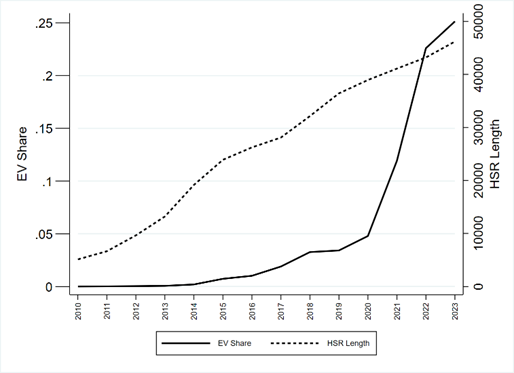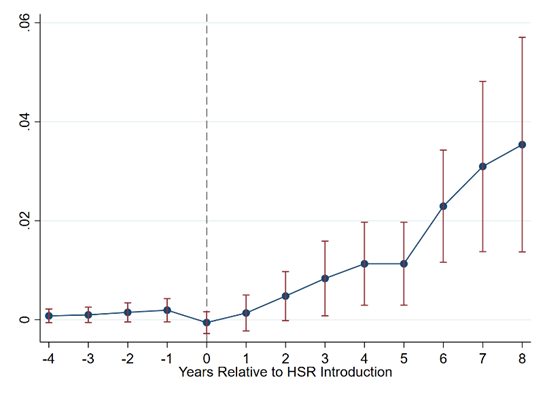
Improved transport infrastructure can accelerate the transition to electric cars by alleviating range anxiety. Evidence from China suggests that the expansion of high-speed rail connectivity accounted for up to one-third of the increase in electric vehicle market share and sales in China from 2010 to 2023, with effects particularly pronounced in cities served by faster HSR lines.
Editor's note: This is a repost of an article that first appeared on VoxChina with slight edits.
Countries worldwide are investing heavily in the electric vehicle (EV) industry, using subsidies and industrial policies to accelerate adoption. While these measures have played a key role, EV adoption rates still vary significantly across countries. Surprisingly, China has emerged as the global leader, achieving a market share of up to 45% for EVs among new vehicle purchases in 2024, compared to 25% and 11% in Europe and the US, respectively. This rapid growth is particularly striking given that China’s EV market was virtually non-existent in 2015.
Why have electric vehicles taken off in China?
Most studies attribute this surge to China’s generous subsidies, industrial policies, and technological advancements (Michalek et al. 2011, Gillingham & Stock 2018, Springel 2021). In response to China’s dominance, the US and EU have imposed tariffs on Chinese EVs, citing ‘unfair subsidies’. However, similar subsidies and policies in other major economies have not produced comparable results, leading to a growing debate over whether government-led incentives alone explain China’s exceptional success. This raises a critical question: What unique factors distinguish China’s EV market?
The answer may lie in an overlooked yet crucial factor: the role of HSR in mitigating EV range anxiety and accelerating adoption. From the completion of the first HSR between Beijing and Tianjin in 2008, China has built the world’s largest HSR network, surpassing 45,000 km by 2023 and connecting 96% of the cities that have populations exceeding 500,000, as shown in Figure 1. In our recent research (Fang et al. 2025), we provide robust evidence that this vast and expanding HSR system has played a significant complementary role in EV adoption, accounting for up to one-third of the increase in EV market share.
Figure 1: National trends in EV market share and HSR network expansion

High-speed rail unlocked electric vehicle adoption in China
To examine how HSR expansion influences EV adoption, we use a city-month panel dataset that tracks new and pre-owned vehicle registrations and insurance records across 328 prefectural cities in China from 2010 to 2023. Our baseline identification strategy relies on a staggered difference-in-differences (DID) framework, utilising the different timing of HSR introduction across cities as a quasi-natural experiment. We compare changes in EV market share and sales before and after HSR implementation in cities newly connected to the network (treatment group) with those not yet connected (control group). Our findings show that HSR connectivity significantly boosts EV market share and sales volume, with average increases of 1.22 percentage points and 91.39%, respectively. This increase is significant, as the average EV market share during the sample period was only 4%. HSR expansion could potentially explain around one-third of the increase in the EV share during this period.
To further strengthen the identification, we apply the Callaway and Sant’Anna DID estimator (CSDID), which accounts for differences in treatment effects across time and cohorts (Callaway & Sant’Anna 2021). Figure 2 plots the change in EV market share relative to the event year of HSR introduction (year 0). It shows that, after a city is connected to the HSR, a clear treatment effect emerges, with EV market share rising by one percentage point initially and expanding to 3.7 percentage points over time, suggesting that the impact of HSR on EV adoption is both immediate and progressively intensifying.
Figure 2: The dynamic response of EV market share

We then apply an instrumental variable (IV) approach, using the historical railway network from 1962 and least-cost straight-line network as instruments to address potential endogeneity concerns. Specifically, the historical railway network reflects the centralised planning objectives of the 1960s, designed to transport raw materials and goods between major cities and provincial capitals under China's five-year plans. The least-cost straight-line network is calculated based on geographic constraints and cost-minimisation principles connecting major megacities. These historical and geographical variations are unlikely to affect EV adoption directly and instead provide an exogenous measure of HSR connectivity.
Additionally, we test the robustness of our results using an alternative treatment measure: market access (MA) growth induced by HSR expansion, which is a continuous measure of the connectivity of the transportation network, incorporating information on the geographical distribution of economic activities and reduction in travel time facilitated by HSR. We follow Borusyak and Hull (2023)’s IV strategy to address potential endogeneity concerns of the measure, and our results remain robust in both economic and statistical significance. These findings imply that China’s HSR network has indirectly mitigated range anxiety by providing a reliable long-distance travel alternative, thereby increasing the attractiveness of EVs for daily commuting and short trips.
What explains the link between high-speed rail and electric vehicle adoption?
We then examine the potential competing and complementary mechanisms linking HSR connectivity and EV adoption, with a focus on local industrial policies, the expansion of charging infrastructure, supply-side factors, and regional economic development. Our main finding is that HSR connectivity continues to be a significant driver of EV adoption, even after accounting for various economic and policy factors. Moreover, our findings indicate that consumer purchase subsidies are particularly effective in cities with HSR connectivity, emphasising the complementary role of HSR networks and policy support in promoting EV adoption. We also identify a positive interaction between HSR connectivity and charging infrastructure, suggesting that HSR enhances the impact of charging stations on EV adoption. Furthermore, our heterogeneous analysis shows that the impact of HSR connectivity on EV adoption is stronger in cities served by faster HSR services and is more pronounced in the eastern and central regions.
Our study is unique in that it examines the impact of China’s HSR system, which was planned before the EV take-off and not specifically designed as a policy to accelerate the adoption of EVs. We provide new insights into the synergies between large-scale infrastructure projects and market-driven transitions to electric mobility. By mitigating range anxiety and providing a reliable alternative for long-distance travel, HSR enhances the practicality of EVs, making them more appealing to consumers. Our findings offer valuable lessons for the design of integrated strategies to accelerate EV adoption and foster sustainable transportation systems around the world.
References
Borusyak, K. and Hull, P. (2023). "Nonrandom exposure to exogenous shocks." Econometrica, 91(6): 2155–2185.
Callaway, B. and Sant’Anna, P. H. C. (2021). "Difference-in-differences with multiple time periods." Journal of Econometrics, 225(2): 200–230.
Fang, H., Li, M., Wang, L. and Yang, Y. (2025). "High-speed rail and China’s electric vehicle adoption miracle." NBER Working Paper 33489.
Gillingham, K. and Stock, J. H. (2018). "The cost of reducing greenhouse gas emissions." Journal of Economic Perspectives, 32(4): 53–72.
Michalek, J. J., Chester, M., Jaramillo, P., Samaras, C., Shiau, C. N. and Lave, L. B. (2011). "Valuation of plug-in vehicle life-cycle air emissions and oil displacement benefits." Proceedings of the National Academy of Sciences, 108(40): 16554–16558.
Springel, K. (2021). "Network externality and subsidy structure in two-sided markets: Evidence from electric vehicle incentives." American Economic Journal: Economic Policy, 13(4): 393–432.




